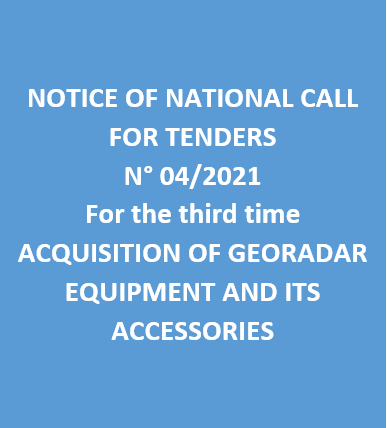| Annual program and technical progress report |
-

Activity Report 2023
-

Technical Program 2024
|
| Geocatalogue |

|
| Invitation to
tender |
-

REALIZATION OF THE TRAINING PLAN FOR THE YEAR 2022
-

ACQUISITION OF TWO SERVICE CARS
-

ACQUISITION OF GEORADAR EQUIPMENT AND ITS ACCESSORIES
|
|
Invest in Tunisia |

|
|
|
|
|
::
Documentation and Editions
>>
Research library
|
| |
|
[
Search by author
]
[
Search keyword
]
[
Search by index
]
[
Search by category
]
|
title of the reference :
|
The saliferous diapirs
|
|
Publication Date:
|
1997
|
|
Author :
|
Charef Abdelkrim
|
|
Catalogue type :
|
Livre
|
|
Catalogue reference :
|
The saliferous diapirs what is the role played in the formation processes of peridiapiric ore deposit in Northern Tunisia. Lead-Zinc mineralization associeted with saliferous diapir have been knonw and exploited for a long time in Tunisia, Algeria, Spain, Gulf of Mexico. Our question what is exactly the role played by these saliferous extrusion in Tunisia. These extrusions of diapir zone (North Tunisia)provide or not the metals for these peridiapirc mineralizations or it played an indirect role. In Gulf coast, the Jurassic formation evaporites are knonw intruding siliciclastic Cretaceous to Quaternary sediments. Schematic cross section of Gulf Coast salt dome shows one good sequence of cap-rock lithotypes. Based on different studies of these cap-rocks, the petrologic and geochemistry evidences indicate that the mineralization fluids have been introduced along the slat/wall rocks contact. The movement of the salt and the generation and the deposition of metals must be at the proper stage in their development to intercept and capture the metals carried by the fluids migration from the basin. In spite, the surface exposure and shallow drilling (by ONM)of North Tunisian domes are dominated by chaotic gypsum, dolomite, marly shale and sandstone, limestone, halite, anydrite, and neoformation minerals. Different Pb-Zn mineralizations are associated with the peridiapiric zone of Fej el Adoum, Bou Grine, Slata, Ghern Halfaya and others. résumé diapir ; plomb ; zinc ; minéralisation ; Tunisie ; Tunisie Nord Occidentale ; Tunisie Nord Orientale ; Fej el Adoum ; Bou Grine ; Slata ; Ghern Halfaya Charef Abdelkrim Gîtologie
|
|
Indexation decimale :
|
Gîtologie
|
|
Keywords :
|
diapir ; plomb ; zinc ; minéralisation ; Tunisie ; Tunisie Nord Occidentale ; Tunisie Nord Orientale ; Fej el Adoum ; Bou Grine ; Slata ; Ghern Halfaya
|
|
Summary :
|
Lead-Zinc mineralization associeted with saliferous diapir have been knonw and exploited for a long time in Tunisia, Algeria, Spain, Gulf of Mexico. Our question what is exactly the role played by these saliferous extrusion in Tunisia. These extrusions of diapir zone (North Tunisia)provide or not the metals for these peridiapirc mineralizations or it played an indirect role. In Gulf coast, the Jurassic formation evaporites are knonw intruding siliciclastic Cretaceous to Quaternary sediments. Schematic cross section of Gulf Coast salt dome shows one good sequence of cap-rock lithotypes. Based on different studies of these cap-rocks, the petrologic and geochemistry evidences indicate that the mineralization fluids have been introduced along the slat/wall rocks contact. The movement of the salt and the generation and the deposition of metals must be at the proper stage in their development to intercept and capture the metals carried by the fluids migration from the basin. In spite, the surface exposure and shallow drilling (by ONM)of North Tunisian domes are dominated by chaotic gypsum, dolomite, marly shale and sandstone, limestone, halite, anydrite, and neoformation minerals. Different Pb-Zn mineralizations are associated with the peridiapiric zone of Fej el Adoum, Bou Grine, Slata, Ghern Halfaya and others.
|
|
Exemplaries :
|
TU1993
|
|
|
|
|
|
|
|



